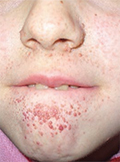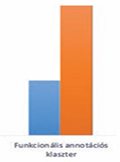The eLitMed.hu medical portal uses computer cookies for convenient operation. Detailed information can be found in the Cookie-policy.
Clinical Neuroscience - 2017;70(03-04)
Content
Procedural learning and its consolidation in autism spectrum disorder
Children with autism spectrum disorder (ASD) show altered learning and memory. A number of recent studies have debated whether procedural learning in ASD is intact or not. Our aim was to further assess the question of whether the implicit, non-conscious form of procedural learning in ASD children is intact or not, furthermore, how shifts towards a more explicit, attention-demanding task setting can alter this performance. We administered a modified version of the Alternating Serial Reaction Time (ASRT) Task to children with ASD and IQ- and age-matched typically developing (TD) children. The task consisted of alternating blocks of cued (explicit) and uncued (implicit probe) blocks, and was repeated after a 16-hour delay. We found that ASD and TD children showed similar sequence-specific learning in cued explicit blocks, however, on the uncued probe blocks ASD children performed better compared to TD children. After the 16-hour delay both groups showed retention of the previously acquired knowledge. Finally, when we investigated the performance in different parts of the blocks, we found that ASD children did not show an effect of fatigue by the second part of the blocks. Our results suggest that children with ASD have increased implicit procedural learning skills compared to TD children. Differences in cued (explicit) and uncued (implicit) settings indicate that children with ASD are not affected by the lack of explicit instructions in probe blocks, suggesting a resistance for changes in task settings. These findings can help in a more thorough planning of cognitive therapeutic setups for ASD children.
[Relationship between sport and traumatic brain injury - risks and sequelaes]
[Traumatic brain injury represents major public health problem worldwide. A typical form of brain injuries is the injury suffered during sports, which according to severity ranges from mild injuries to fatal damages. The significance of the sport related minor head injuries derives form the high incidence, the excessive involvement of the younger age groups, and their potential repetitive nature. The repeated mild head injuries may accumulate, leading to complex structural, neurochemical, neuroendocrine, and psychological alterations, which in long term may result in changes of the patients quality of life and in significant deterioration of participation in the everyday activity. Actually we neither have enough knowledge about the ne-gative consequences, nor the way of prevention, or protection against the harmful long term results. With this study summary we would like to draw attention to the potential hazards emerging from sport injuries, moreover we would like to emphasize the importance of study participation and follow up of articles in this field.]
Surveillance and management of patients with tuberous sclerosis complex
Tuberous sclerosis complex (TSC) is an autosomal dominant disease due to the uncontrolled differentiation, proliferation, and migration of cells in several organs. Clinical expression is highly variable, from mild skin findings and asymptomatic brain lesions to seizures, mental retardation, autism, and potentially fatal kidney, cardiac, or pulmonary disease. Aim of this paper is to summarize the diagnostic criteria, surveillance and therapeutic issues of this multisystemic disorder emphasizing the most important neurological consequences. Presenting the state-of-the-art management recommendations and comparing them with the local protocols, we hope that our review might help in the proper assessment of one of the most important single gene disorder.
[A családorvosok alvási apnoéval kapcsolatos ismeretei és attitűdjei. Megvalósul-e az OSAS szűrése a járművezetők egészségi alkalmasságának vizsgálata során?]
[Objective - Obstructive sleep apnea syndrome (OSAS) without treatment can cause serious cardiovascular, cardiorespiratory, neurological and other complications. Family physicians have an important role in recognizing the disease. The aim of the study is to assess the knowledge and attitude of family physicians related to sleep apnea. Whether OSAS screening is realized during the general medical checkup for drivers. Methods - In the cross-sectional study we used a validated OSAKA questionnaire in mandatory continuous medical education courses, supplemented with four additional questions. Results - 116 family physicians and 103 family medicine residents filled out the questionnaire. Hungarian family physicians, especially male doctors lack the adequate knowledge of sleep apnea. The average score of female physicians was significantly higher than that of males (13.4±1.8 vs. 11.7±2.6, p=0.005). The more sprecializations the doctor has, the higher the score. Zero or one special examination holders reached 12.5±2.3 points, two special examination holders 12.7±2.2 points. three or four special examination holders reached 14.0±2.1 (p=0.05). Residents’ average score was 12.1±2.4 points, which is higher than that of family doctors (p=0.012). Female residents also had higher average points than male residents (12.6±2.0 vs. 11.3±2.7; p=0.008). The size, location and type of the practice or the doctor’s age did not show any statistically significant correlation with the number of points achieved. According to our regression analysis, corrected to variables in the model, we found correlation between gender and medical knowledge, but there was no correlation between age, number of specialities, body mass index and the theoretical knowledge of the doctors. In terms of attitude female GPs had higher average scores than male GPs (3.5±0.6 vs. 2.9±0.6, p<0.001). Despite the modification of the 13/1992 regulation only 39% of the practices carried out regularly the required OSAS screening as part of the medical examination for a driving licence. Conclusions - Despite the high prevalence and clinical importance of OSAS, GPs often do not recognize sleep apnea and they have difficulty in treating their patients for this problem.]
[Multilocus genetic analysis implicates neurodevelopment and immune system in the etiology of schizophrenia]
[Background - Schizophrenia is a severe psychiatric disorder of poorly understood etiology, characterized by high heritability, multifactorial inheritance and high heterogeneity. Multilocus associaton methods may reduce the genetic heterogeneity and improve the probability of replication between analyses. Objectives - The aims of our study were twofold: 1. To analyse genetic risk factors of schizophrenia by using multilocus genetic tests. 2. To assess the replication probability attributable to the various multilocus tests. Subjects - Discovery set: case-parent trios of unaffected parents and affected probands with a DSM-IV schizophrenia diagnosis (n=16); replication set: schizophrenia cases and unaffected controls (n=5337). Methods - Associations of single nucleotide and indel markers were transferred to gene- and geneset-based associations, furthermore to geneset-enrichment tests and functional annotation cluster analyses in a two-staged designs. Associations with p<0.1 from the discovery set were tested in the replication sample. Familywise p-value correction for multiple comparisons were performed during the replication step. Results - After correction for multiplicity, no significant association or enrichment were detected for gene-based nor canonical pathway analyses, but significant association of the 14q31 cytoband and enrichments of the 5q31 and Xq13 cytobands were found (p_corr: 0.002, 0.006 and 0.048, respectively). Functional annotation clustering yielded statistically significant enrichment scores for clusters of splicing/alternative splicing, neurodevelopment and embryonic development. Improvements in replication probabilty were found with increased test complexity (P_rep: 0, 0.015, 0.21). Conclusions - Our results corroborate the involvement of neurodevelopment, synaptic plasticity and immune mechanisms in the etiology of schizophrenia. Also, our findings indicated improvement of replication probability by using multilocus genetic analyses. ]
Electrophysiological alterations and general toxic signs obtained by subacute administration of titanium dioxide nanoparticles to the airways of rats
Introduction and aims - Particles of titanium dioxide (TiO2) with typical size below 100 nm have gained a broad range of application by now, partly involving direct human exposure. Their known properties - high specific surface, mobility within the organism, induction of oxidative stress, release of inflammation mediators etc. - raise the possibility of nervous system damage but the available data regarding this are scarce and contradictory. Based on that, and the experiences with other metal oxide nanoparticles, the aim of the present study was to investigate certain general end nervous system toxic effects of TiO2 nanoparticles applied in the airways of rats. Materials and methods - Young adult Wistar rats (5 groups of 10 rats each) received, daily for 28 days, intratracheal instillations of titanium dioxide nanoparticles of ca. 10 nm diameter, suspended in 1% hydroxyethyl cellulose dissolved in phosphate-buffered saline, in the doses of 1, 3, and 10 mg/kg b. w. Vehicle controls received the suspension medium and there was also an untreated control group. During treatment, the rats’ body weight was measured, and their clinical state observed, daily. After the 28 days, spontaneous cortical activity, sensory evoked potentials and tail nerve action potential was recorded in urethane anesthesia, then the rats were dissected and tissue samples were taken for Ti level determination and biochemical measurements of some oxidative stress indicators. Results - The two higher doses reduced the rate of body weight gain significantly. Sensory evoked potentials and tail nerve action potential were significantly slowed, but the change in the spectrum of spontaneous cortical activity was not significant. Correlation of moderate strength was found between certain evoked potential parameters and brain Ti level and oxidative stress data. Conclusion - Our results underlined the possible neurotoxicity of TiO2 NPs but also the need for further investigations.
Different work schedules of nurses in Hungary and their effects on health
Introduction - The shift work is burdensome for nurses and may lead to health problems. Aims - The purpose of the study was to examine the nursing shift system types and to analyse the effects on nutritional status, subjective state of physical and mental health in case of different shift schedules. Method - In the first phase of the research 326 nurses working in changing shifts filled out the Bergen Shift Work Questionnaire after adaptation into Hungarian. 518 nurses participated in our second study in hospitals of the South-Danubian Region, in clinics of University of Pécs and at trainings organized by the Faculty of Health Sciences of the University of Pécs. Results - Based on the psychometric characteristics of Bergen Shift Work Questionnaire technically it is suitable for the examination of sleeping disorders associated with shift work. Sleeping quality is worse in those working in irregular work shifts compared to those working in regular and flexible work schedules (p<0.001). The irregular work schedule is worse than the regular work schedule according to 76.6% of the nurses. According to 63.8% of the respondents the following regular work schedule is the best: after one 12-hour day shift one 12-hour night shift, followed by two days of rest. The average Body Mass Index (BMI) is 26.16 kg/m2. Since the nurses work in shift work 47.7% of them reported weight gain. Among the psychosomatic symptoms the most frequent is back pain (78.4%) related elevated BMI (p=0.013). The nurses’ sense of coherence on average is 61.76 points. In case of full-time employees the sense of coherence is better than those who work in shifts (t=2.933, p=0.004). The nurses working irregular shift work asses their health worst (mean rank: 166.61; p=0.019), and their sense of coherence is lower (p=0.04). Conclusion - The irregularity of work schedules is stressful for nurses. Due to the health of nurses it would be useful to establish the least exhausting work schedules.
Pazopanib induced unilateral posterior reversible encephalopathy syndrome
Posterior reversible encephalopathy syndrome (PRES) is a reversible clinical and neuroradiological syndrome which may appear at any age and characterized by headache, altered consciousness, seizures, and cortical blindness. The exact incidence is still unknown. The most commonly identified causes include hypertensive encephalopathy, eclampsia, and some cytotoxic drugs. Vasogenic edema related subcortical white matter lesions, hyperintense on T2A and FLAIR sequences, in a relatively symmetrical pattern especially in the occipital and parietal lobes can be detected on cranial MR imaging. These findings tend to resolve partially or completely with early diagnosis and appropriate treatment. Here in, we present a rare case of unilateral PRES developed following the treatment with pazopanib, a testicular tumor vascular endothelial growth factor (VEGF) inhibitory agent.
1.
Clinical Neuroscience
[Headache registry in Szeged: Experiences regarding to migraine patients]2.
Clinical Neuroscience
[The new target population of stroke awareness campaign: Kindergarten students ]3.
Clinical Neuroscience
Is there any difference in mortality rates of atrial fibrillation detected before or after ischemic stroke?4.
Clinical Neuroscience
Factors influencing the level of stigma in Parkinson’s disease in western Turkey5.
Clinical Neuroscience
[The effects of demographic and clinical factors on the severity of poststroke aphasia]1.
2.
Clinical Oncology
[Pancreatic cancer: ESMO Clinical Practice Guideline for diagnosis, treatment and follow-up]3.
Clinical Oncology
[Pharmacovigilance landscape – Lessons from the past and opportunities for future]4.
5.










